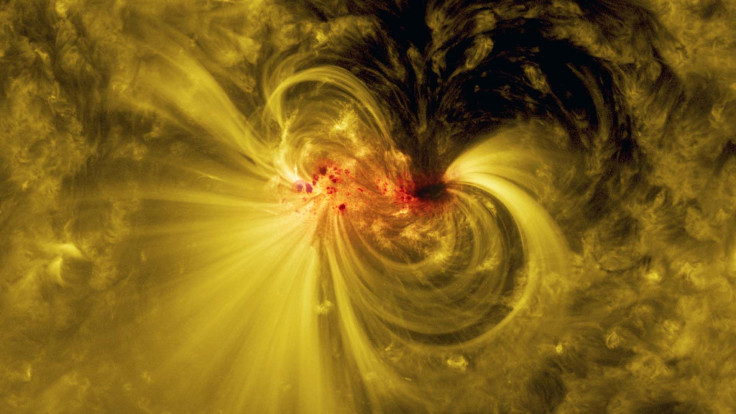NASA Observes Sunspot For 2 Weeks Ahead Of August 21 Solar Eclipse

Sunspots are regular phenomena on the sun, but their frequency decreases when the sun moves into a period of lower activity during solar cycles that are about 11 years long. NASA announced Friday it observed a sunspot — an active area on the face of the sun which has “intense and complex magnetic fields” — for 13 days in July, weeks ahead of the upcoming total solar eclipse on Aug. 21.
Called AR12665, the sunspot was first seen July 5 as it rotated into view of NASA’s Solar Dynamic Observatory, and SDO continued observing it as it passed across the face of our star, finally going out of view July 17. And despite the sun moving toward the period of low activity in its cycle (called the solar minimum), the sunspot gave astronomers plenty to see.
Read: Temperature Of Sun’s Corona Could Be Linked To Magnetic Activity
On July 9, AR12665 emitted a medium-size solar flare that peaked at 11:18 a.m. EDT. It was categorized as an M1 flare, where M category flares are only about a tenth the size of the largest and most intense flares, categorized as X. An M2 flare, which is twice the intensity of an M1, was seen on July 14, and lasting over two hours, it peaked at 10:09 a.m. EDT.
Solar flares are a type of explosion on the sun’s surface, and they send out large amounts of light, energy and high-speed particles into space. Another type of solar explosion is called coronal mass ejection, and a CME was also seen with the July 14 flare (solar flares and CME are often associated).
A CME sends giant clouds of solar material and energy from the sun’s corona into space at high speeds. The one accompanying the July 14 flare was seen leaving the sun at 9:36 a.m. EDT, moving at speeds of about 620 miles a second before eventually slowing down to about 465 miles per second. The sunspot also emitted a stream a high-speed protons in a phenomenon called solar energetic particle event, which was seen at 12:45 p.m. EDT the same day. These observations were all made by the Solar & Heliospheric Observatory, a spacecraft launched in 1995 as a collaboration between NASA and the European Space Agency.
Sunspots are useful and important to study not only because they provide information about the inner workings of our host star; understanding them is significant also because they are an important factor in space weather. The July 14 flare, for example, led to increased aurora activity on Earth when it crossed the 93 million miles that separate us from the sun, reaching here July 16. The bursts of radiation that travels to Earth due to the flares can also have a negative impact on our satellites and communication systems.
Read: The Sun Had A Twin A Long Time Ago
NASA said in its statement researchers at its Goddard Space Flight Center in Greenbelt, Maryland, “used these spacecraft observations as input for their simulations of space weather throughout the solar system.”
SDO was launched Feb. 11, 2010, into a geosynchronous orbit directly above its ground station in New Mexico. This is necessary because the satellite has no data recording system, and the large volume of data it collects is transmitted to and stored in its very own ground station.
The upcoming solar eclipse is the first in 99 years when it will be visible in totality from mainland United States. Even as there are many viewing parties being organized around the country, the stellar phenomenon will allow scientists to gather a lot of valuable data.
© Copyright IBTimes 2025. All rights reserved.





















